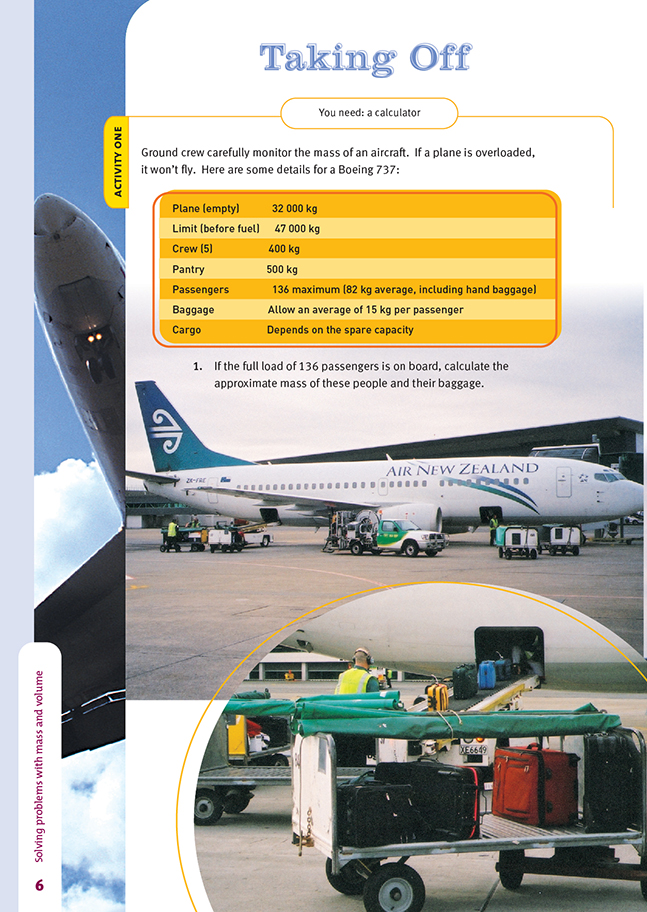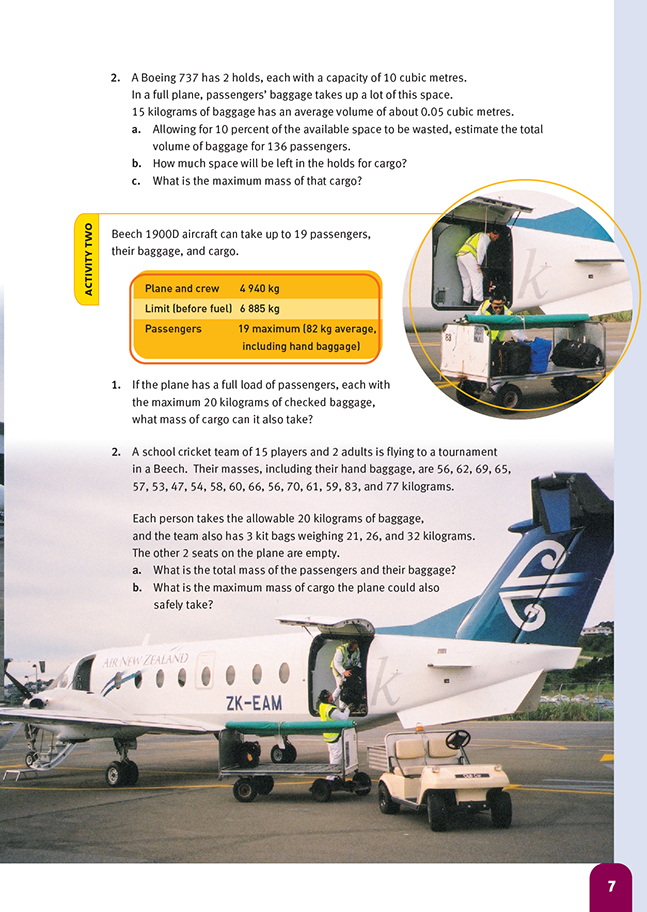This is a level 4 measurement strand activity from the Figure It Out series.
A PDF of the student activity is included.
Click on the image to enlarge it. Click again to close. Download PDF (271 KB)
solve problems with mass and volume
calculator
FIO, Level 4, Measurement, Book One, Taking Off, pages 6-7
Activity One
Both activities are based on the fact that a plane can’t take off if its mass exceeds a carefully calculated limit.
The students may find that the reading and interpretation involved in this task is just as much a challenge as the maths. The information they need is all there in the panel, but it may not be immediately obvious to them what they should do with it.
Question 1 asks the students to make an accurate calculation using specific figures and to come up with a specific answer (13 192 kilograms). But because their accurate calculation is based on a figure that is an estimate (the average mass of a passenger and their hand baggage = 82 kilograms), their answer is also an estimate.
Some educational suppliers now sell kits of 12 metre-long sticks and 8 corner joints, from which you can construct a wire-frame “cubic metre”. One of these could help the class to visualise what sort of space 20 cubic metres is. Also, if they work out the volume of their classroom, or their bedroom, they will be able to relate the size of the 737’s holds to this known space.
The students may need some help with the 10 percent wastage referred to in question 2a. The answers incorporate the 10 percent into the calculation, using the multiplier 1.1 ( = 110%). An alternative is to find 10 percent of the volume and add this to the total.
For 2b, the students need to note that there are two holds, each with a capacity of 10 cubic metres (this is explained at the start of the question but may get overlooked).
When answering question 2c, the students need to go back to the “before fuel” limit of the plane (found in the panel) and subtract from this the mass of the empty aircraft, crew, pantry, and passengers (which was calculated in question 1). What is left is the mass of cargo that can be carried.
Activity Two
This activity gives the individual masses of passengers and their hand baggage. In practice, operators do not weigh individuals, but they do make allowances if their human cargo is atypical (for example, members of an adult male sports team are assigned a weight of 93 kilograms instead of the usual 82 kilograms). In this case, the fact that the mean weight of the passengers is well below the standard 82 kilograms means that the plane could safely carry more cargo, whether or not the operator chooses to do so.
Note
Although the maths and procedures have been simplified, these activities are modelled closely on the weights and allowances used for the Boeing 737 and the Beech 1900D. Nervous students can be assured that the weight limits leave a sizeable safety margin, so their lives will not be in danger if someone puts one too many books in their hand baggage!
For full details on Air New Zealand’s baggage rules, see:
www.airnz.co.nz/travelinfo/ontheplane/baggageinformation/default.htm
Answers to Activities
Activity one
1. 13 192 kg in total. This is made up of 136 x 82 = 11 152 kg (passengers and hand baggage) and 136 x 15 = 2 040 kg (baggage for the hold).
2. a. 7.48 m3. (136 x 0.05 x 1.1 = 7.48 m3. Note: 110% = 110 = 1.1)
b. 12.52 m3. (20 – 7.48 = 12.52 m3 )
c. 908 kg. (Mass of aircraft, food, crew, passengers, and baggage = 32 000 + 400 + 500 + 11 152 + 2 040 = 46 092 kg. Maximum mass before fuel is 47 000 kg, leaving 47 000 – 46 092 = 908 kg for cargo.)
Activity two
1. 7 kg (effectively none!)
(19 passengers at 82 kg = 1 558 kg. 20 kg baggage for 19 passengers = 380 kg. Plane + crew + passengers + baggage = 6 878 kg. Limit before fuel = 6 885 kg.)
2. a. 1 053 kg
b. 473 kg, or nearly half a tonne.
(Plane + crew + passengers + baggage = 6 412 kg, which is 473 kg less than the 6 885 kg limit before fuel.)

